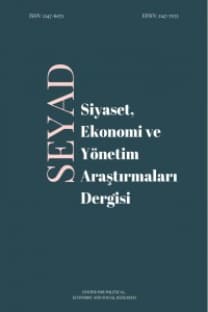The Neoclassical Determinants of Real Wage
The Neoclassical Determinants of Real Wage
This paper presents empirical evidence that the neoclassical explanation of real wage has a high explanatory power at macro level. The factor endowments explanation of the real wage is surprisingly rare in the literature, at least at empirical level. In this paper, using panel data from 26 OECD countries, we show that the factor endowments-technology, physical capital stock and labor stock- have a significant explanatory power on the determination of the real wage. Based on our findings, we speculate that the supply-side rather than the demand-side variables may be the major source of the wage differences across countries
Keywords:
Wage, factor endowment inter-country wage differences, panel data, panel SUR,
___
- Alback, K., Arai, M., Asplund, R., Barth, E. and Madsen, E. S. (1993) Inter- industry wage differentials in the Nordic countries, Paper presented at the European Association of Labor Economists Annual Conference, Papers and proceedings, EALE, Maastricht, pp. 1- 23.
- Baltagi B. (2008), Econometric Analysis of Panel Data, Third Edition John Wiley & Sons Ltd, England.
- Behr, A and U. Pötter (2010), “What Determines Wage differentials across the EU?” The Journal of Economic Inequality March 2010, Volume 8, Issue 1, pp 101-120
- Caju, P.D., G. Kátay, A. Lamo, D. Nicolitsas and S. Poelhekke (2010) “Inter- Industry Wage Differentials in EU Countries: What Do Cross- Country Time Varying Data Add to The Picture?”, European Central Bank Working Paper Series, No 1182 / April 2010
- Clemens, M., C. Montenegro, and L. Pritchett (2008), “The Place Premium: Wage Differences for Identical Workers across The US Border,” World Bank Policy Research Working Paper No. 4671
- Dickens, W. T. and Katz, L F. (1987) “Inter-industry wage differences and industry characteristics”, In Unemployment and the Structure of Labor Markets, (Eds) K. Lang and J. Leonard, Blackwell, Oxford, pp. 48-89.
- Erdil, E. and H. Yetkiner, (2001) “A comparative analysis of inter-industry wage differentials: industrialized versus developing countries”, Applied conomics, 33, 1639-1648.
- Gittleman, M. and Wolff, E. N. (1993) “International comparisons of inter- industry wage differentials”, Review of Income and Wealth, 39, 235- 312.
- Greene, W.H. (2008), Econometric Analysis, 6th Ed., Upper Saddle River, N.J.: Prentice-Hall.
- Groshen, E. L. (1991) “Five reasons why wages vary among employers”, Industrial Relations, 30, 350- 81.
- Kennan, J.(2012), “Open Borders”, World Bank Policy Research Working Paper No. 18307.
- Krueger, A. B. and Summers, L. H. (1987) “Reflections on the inter-industry wage structure”, In Unemployment and the Structure of Labor Markets, (Es) K. Lang and J. Leonard, Blackwell, Oxford, pp. 17- 47.
- Krueger, A. B. and Summers, L. H. (1988) “Efficiency wages and the inter- industry wage structure”, Econometrica, 56, 259- 94.
- Lucas, R. Jr., (1988). “On the mechanics of economic development”, Journal of Monetary Economics, 22(1), 3-42.
- Mankiw, N.G. (2006, August 29). “How are wages and productivity related?” Retrieved from http://gregmankiw.blogspot.com/2006/08/how-are- wages-and-productivity-related.html
- O'Rourke, Kevin H. and Jeffrey G. Williamson (1999) “Globalization and History: The Evolution of a Nineteenth-Century Atlantic Economy”. Cambridge, MA: MIT Press.
- Pesaran H. (2004) “General Diagnostic Tests for Cross Section Dependence in Panels”, University of Cambridge, 2004 CWPE 0435
- Pesaran, M. H., (2007), “A Simple Panel Unit Root test in the presence of Cross-section Dependence”, Journal of Applied Econometrics, 22, 265-312.
- Wagner, J. (1990) “An International Comparison of Sector Wage Differences”, Economics Letters, 34, 93- 7.
- Westerlund J. (2008), “Panel Cointegration Tests of the Fisher Effect”, Journal of Applied Econometrics, 23, 193-233.
- ISSN: 2147-6071
- Yayın Aralığı: Yılda 2 Sayı
- Başlangıç: 2014
- Yayıncı: Politik Ekonomik ve Sosyal Araştırmalar Merkezi
